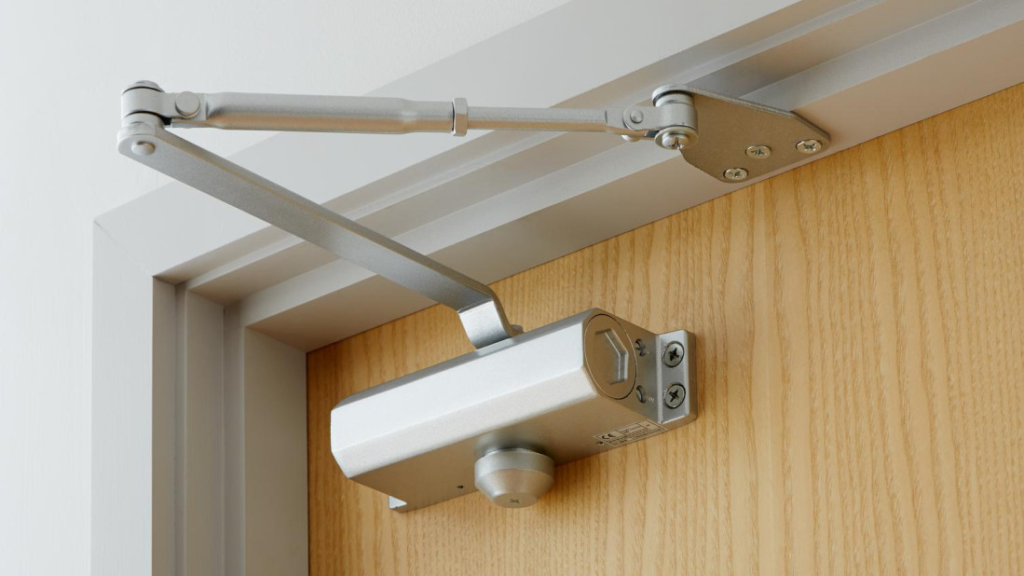Door closers are essential components in modern buildings. Whether used in commercial offices, hospitals, schools, hotels, or residential entrances, they ensure doors close safely, quietly, and automatically. But what exactly makes them work?
In this article, we explain how door closer work, their internal structure, and why understanding the mechanism can help you choose better hardware.

🔍 What Is a Door Closer?
A door closer is a mechanical device that automatically returns a door to its closed position after it has been opened. It plays a critical role in:
- Maintaining indoor climate control (by preventing doors from being left open)
- Enhancing building security
- Meeting fire safety regulations
- Preventing damage to doors and frames from slamming
⚙️ How Does a Door Closer Work?
At the core of most door closers is a combination of mechanical springs and hydraulic (or pneumatic) control systems. Here’s a breakdown of the process:
1. Opening the Door
When someone pushes or pulls the door open, this action engages a spring inside the closer. The energy from this motion is stored in the compressed spring.
2. Controlling the Closing Speed
As soon as the user releases the door, the compressed spring pushes the arm and door back toward the closed position.
But if the door closed only under spring force, it would slam shut — fast and dangerously. To solve this, manufacturers use hydraulic oil inside a sealed chamber, which flows through valves at a controlled rate to slow the door down.
3. Two-Speed Closing System
Most commercial-grade door closers feature two (or more) control valves:
- Main Closing Speed: Controls how fast the door moves from fully open to about 15° before closing.
- Latching Speed: Controls the final few degrees, ensuring the door fully latches but without slamming.
- Optional Delayed Action: Available in some models, this slows the closing process even more for accessibility needs (e.g., hospitals, elderly facilities).
Each of these can usually be adjusted using small screws on the body of the closer.
🧩 Main Components of a Door Closer (Surface-Mounted Type)
| Component | Function |
|---|---|
| Spring Mechanism | Stores and releases energy to close the door |
| Piston & Cylinder | Moves under pressure, regulating movement |
| Hydraulic Oil | Slows the return movement of the door to prevent slamming |
| Adjustment Valves | Fine-tune closing and latching speeds |
| Arm Assembly | Connects the body of the closer to the door or frame |
| Body Housing | Encases the internal mechanism, often aluminum or steel |
🛠️ Types of Door Closers (Brief Overview)
While this article focuses on surface-mounted closers, here are the most common types:
- Surface-Mounted Closers – Most widely used; installed on the door or frame.
- Concealed Closers – Hidden inside the door or header; used where aesthetics matter.
- Floor Spring Closers – Installed in the floor; often used for heavy glass or swing doors.
- Overhead Concealed Closers (OHC) – Hidden in the top frame; common in aluminum/glass storefronts.
Each type uses similar hydraulic control principles, but installation and maintenance can vary.
✅ Why It Matters for Buyers and Installers
Understanding how a door closer works can help you:
- Select the right model for door size, weight, and usage frequency.
- Install and adjust the closer correctly, avoiding customer complaints.
- Meet fire and safety codes in different countries (such as UL Listed, EN 1154, CE Marking, etc.)
- Reduce long-term maintenance by choosing high-quality closers with durable seals and precise valves.
🔧 Common Adjustment Tips
If your door closer is closing too quickly or slamming, here’s what to do:
- Locate the adjustment screws (usually labeled “S” for sweep, “L” for latch).
- Use a small screwdriver to turn the screw clockwise to slow down the movement.
- Make small changes and test after each adjustment.
- Never remove the screw entirely — it may cause oil to leak and ruin the closer.
📌 Final Thoughts
A door closer may seem like a simple device, but its internal engineering is essential for building safety, comfort, and functionality. Whether you’re a hardware distributor, construction contractor, or door manufacturer, understanding how a door closer works helps you select, install, and maintain it better.
At Yucheng Hardware, we offer a full range of door closers suitable for commercial and residential use, all with customizable force ratings, finishes, and certifications for global markets.
